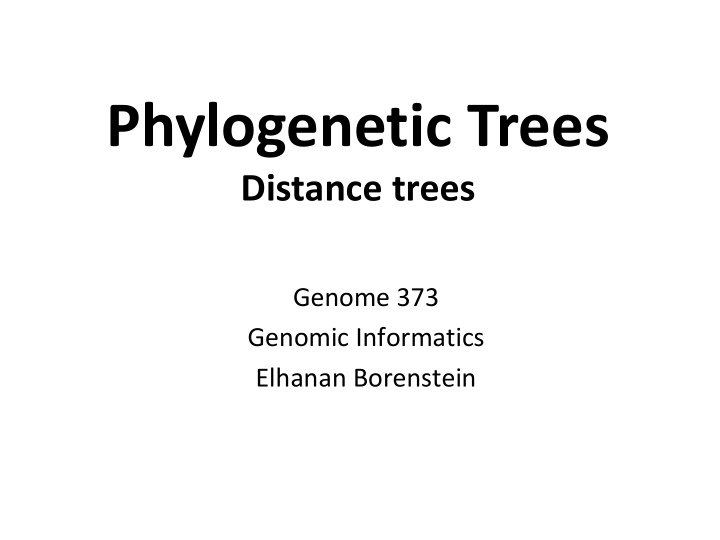



Phylogenetic Trees Distance trees Genome 373 Genomic Informatics Elhanan Borenstein
A quick review Significance of similarity scores (P-values) Empirical null score distribution Extreme value distribution Multiple-testing correction (Bonferroni) and E-values
Multiple alignment
Defining what a “tree” means rooted tree (all real trees are rooted): unrooted tree: ( used when the root isn’t leaves or tips known): branch (eg sequences) points root ancestral sequence branches time radiates out from somewhere (probably near the center) time … sequence divergence is proportional to (horizontal) branch lengths
A tree has topology and distances Are these topologically different trees?
A tree has topology and distances Are these topologically different trees? Topologically, these are the SAME tree. In general, two trees are the same if they can be inter-converted by branch rotations.
Why is inferring phylogeny a hard problem?
The number of tree topologies grows extremely fast 3 leaves 4 leaves 3 branches 5 branches 1 internal node 2 internal nodes 1 topology 3 topologies (x3) (3 insertions) (5 insertions) In general, an unrooted tree with N leaves has: 2N - 3 total branches 5 leaves N leaf branches 7 branches N - 3 internal branches 3 internal nodes 15 topologies (x5) N - 2 internal nodes (7 insertions) 3*5*7*…*(2N -5) ~O(N!) topologies
There are many rooted trees for each unrooted tree For each unrooted tree, there are 2N - 3 times as many rooted trees, where N is the number of leaves (# branches = 2N – 3). 20 leaves - 564,480,989,588,730,591,336,960,000,000 topologies
How can you compute a tree? Many methods available, we will talk about: Distance trees Parsimony trees Others include: Maximum-likelihood trees Bayesian trees
Trees and Distances
Distance matrix methods • Methods based on a set of pairwise distances typically from a multiple alignment. human chimp gorilla orang human 0 2/6 4/6 4/6 chimp 0 5/6 3/6 gorilla 0 2/6 orang 0 (symmetrical, lower left not filled in) • Try to build the tree whose distances best match the real distances.
Best Match? • "Best match" based on least squares of real pairwise distances compared to the tree distances: Let D m be the measured distances. Let D t be the tree distances. Find the tree that minimizes: N 2 D D t m i 1
Enumerate and score all trees? How about the following algorithm: Enumerate every tree topology, fit least-squares best distances for each topology, keep best. Not used for distance trees - there is a much faster way to get very close to correct.
The UPGMA algorithm 1) generate a table of pairwise sequence distances and assign each sequence to a list of N tree nodes. 2) look through current list of nodes (initially these are all leaf nodes) for the pair with the smallest distance. 3) merge the closest pair, remove the pair of nodes from the list and add the merged node to the list. 4) repeat until only one node left in list - it is the root. 1 D d N ij n n 1, 2 definition of i j distance where is each leaf of i n 1 (node1), is each leaf of j n 2 (node2), and is the number of distances su N mm d e (in words, this is just the arithmetic average of the distances between all the leaves in one node and all the leaves in the other node)
UPGMA ( U nweighted P air G roup M ethod with A rithmetic Mean) 1 2 5 3 4
The Molecular Clock UPGMA assumes a constant rate of the molecular clock across the entire tree! The sum of times down a path to any leaf is the same This assumption may not be correct … and will lead to incorrect tree 1 2 reconstruction. 0.1 0.1 0.1 0.4 0.4 3 4
Neighbor-Joining (NJ) Algorithm Essentially similar to UPGMA, but correction for distance to other leaves is made. Specifically, for sets of leaves i and j , we denote the set of all other leaves as L , and the size of that set as |L| , and we compute the corrected distance D ij as: 1 2 0.1 0.1 0.1 0.4 0.4 3 4
Raw distance correction • As two DNA sequences diverge, it is easy to see that their maximum raw distance is ~0.75 (assuming equal nt frequencies, ¼ of residues will be identical even if unrelated sequences). • We would like to use the "true" distance, rather than raw distance. • This graph shows evolutionary distance related to raw distance: DNA
Jukes-Cantor model Jukes-Cantor model: 3 4 D ln(1 D ) raw 4 3 D raw is the raw distance (what we directly measure) D is the corrected distance (what we want)
Mutational models for DNA • Jukes-Cantor (JC) - all mutations equally likely. • Kimura 2-parameter (K2P) - transitions and transversions have separate rates. • Generalized Time Reversible (GTR) - all changes have separate rates. (Models similar to GTR are also available for protein)
Distance trees - summary • Convert each pairwise raw distance to a corrected distance. • Build tree as before (UPGMA algorithm). • Notice that these methods don't need to consider all tree topologies - they are very fast, even for large trees.
Trees and Python
Representing a tree in Python Some bioinformatic entities are easy to represent with standard Python types, e.g. : • Protein or DNA sequence • Alignment score • Sequence names paired with scores (or other things) How would you represent a tree??
Natural approach - represent tree nodes leaf root node nodes (special internal node) internal nodes
1 5 tree nodes 7 numbered for 2 3 reference 6 4 What kinds of information should we associate with nodes? 1) A sequence name (for leaf nodes) 2) A distance to parent (except for the root) 3) Connections to other nodes
Recommend
More recommend